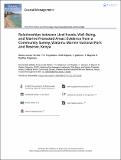Files in this item
Relationships between livelihoods, well-being, and marine protected areas : evidence from a community survey, Watamu Marine National Park and Reserve, Kenya
Item metadata
| dc.contributor.author | Harker, Anna L. | |
| dc.contributor.author | Stojanovic, Tim | |
| dc.contributor.author | Majalia, A.M. | |
| dc.contributor.author | Jackson, C. | |
| dc.contributor.author | Baya, S. | |
| dc.contributor.author | Tsiganyiu, K. Dadley | |
| dc.date.accessioned | 2022-10-17T12:30:21Z | |
| dc.date.available | 2022-10-17T12:30:21Z | |
| dc.date.issued | 2022-11-01 | |
| dc.identifier | 281574060 | |
| dc.identifier | 7f214588-7e9e-46f5-8dfc-2391e8986fe0 | |
| dc.identifier | 000866335800001 | |
| dc.identifier | 85139958625 | |
| dc.identifier.citation | Harker , A L , Stojanovic , T , Majalia , A M , Jackson , C , Baya , S & Tsiganyiu , K D 2022 , ' Relationships between livelihoods, well-being, and marine protected areas : evidence from a community survey, Watamu Marine National Park and Reserve, Kenya ' , Coastal Management , vol. 50 , no. 6 , pp. 490-513 . https://doi.org/10.1080/08920753.2022.2126266 | en |
| dc.identifier.issn | 0892-0753 | |
| dc.identifier.other | ORCID: /0000-0002-8936-2299/work/120849692 | |
| dc.identifier.other | ORCID: /0000-0003-1610-6697/work/153452094 | |
| dc.identifier.uri | https://hdl.handle.net/10023/26205 | |
| dc.description | Funding: UK Global Challenges Research Fund and Scottish Funding Council (projects 'Community Capabilities and Marine Protected Area Governance' and 'Mitigation of the effects of COVID-19 crisis in coastal Kenya XFC092'). | en |
| dc.description.abstract | At a time of massive expansion of Marine Protected Areas, there is a need to learn more about their sustainability and success. This study draws on a framework which operationalizes three-dimensions of well-being: material, relational, and subjective, in order to measure the range of benefits and disbenefits experienced by local communities from protected areas. 308 respondents from two coastal Kenyan villages adjacent to the Watamu Marine National Reserve participated in a telephone survey in June and July 2020. The study recorded varying levels of dependency on the marine environment for the livelihoods of residents. A key finding of this study was that benefits reported by participants consistently exceeded disbenefits. A principal components analysis identified that the number of benefits and disbenefits experienced explained the most variance within the dataset. The benefits and disbenefits reported contributed to each dimension of human well-being. The highest ranked benefits reported contributed to subjective well-being (‘better health’, and ‘ability to enjoy a clean and healthy creek and ocean’), and the most frequently reported disbenefits related to relational and material well-being (for instance ‘increased conflict and social tension’ ‘increased poverty’, ‘fewer supplies of food’). Practical local conservation efforts can address relational disbenefits through better partnership working, and material disbenefits by supporting pro-conservation, alternative livelihoods. The findings demonstrate the relevance of understanding social trends for marine protected area governance and management. The paper offers insights into how fundamental relations between protected marine environments, livelihoods, and well-being may affect the perceptions and success of conservation initiatives amongst local communities. | |
| dc.format.extent | 24 | |
| dc.format.extent | 2406700 | |
| dc.language.iso | eng | |
| dc.relation.ispartof | Coastal Management | en |
| dc.subject | Conservation | en |
| dc.subject | Governance | en |
| dc.subject | Protected areas | en |
| dc.subject | Well-being | en |
| dc.subject | GE Environmental Sciences | en |
| dc.subject | GF Human ecology. Anthropogeography | en |
| dc.subject | E-NDAS | en |
| dc.subject | SDG 3 - Good Health and Well-being | en |
| dc.subject | SDG 14 - Life Below Water | en |
| dc.subject | MCC | en |
| dc.subject.lcc | GE | en |
| dc.subject.lcc | GF | en |
| dc.title | Relationships between livelihoods, well-being, and marine protected areas : evidence from a community survey, Watamu Marine National Park and Reserve, Kenya | en |
| dc.type | Journal article | en |
| dc.contributor.sponsor | Scottish Funding Council | en |
| dc.contributor.institution | University of St Andrews. Geographies of Sustainability, Society, Inequalities and Possibilities | en |
| dc.contributor.institution | University of St Andrews. Coastal Resources Management Group | en |
| dc.contributor.institution | University of St Andrews. School of Geography & Sustainable Development | en |
| dc.contributor.institution | University of St Andrews. Marine Alliance for Science & Technology Scotland | en |
| dc.contributor.institution | University of St Andrews. St Andrews Sustainability Institute | en |
| dc.contributor.institution | University of St Andrews. Scottish Oceans Institute | en |
| dc.identifier.doi | https://doi.org/10.1080/08920753.2022.2126266 | |
| dc.description.status | Peer reviewed | en |
| dc.identifier.grantnumber | en |
This item appears in the following Collection(s)
Items in the St Andrews Research Repository are protected by copyright, with all rights reserved, unless otherwise indicated.

